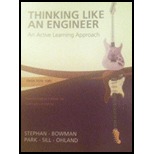
Thinking Like an Engineer
4th Edition
ISBN: 9781269910989
Author: Elizabeth A. Stephan, David R. Bowman, William J. Park, Benjamin L. Sill, Matthew W. Ohland
Publisher: Pearson Learning Solutions
expand_more
expand_more
format_list_bulleted
Concept explainers
Textbook Question
Chapter 14, Problem 12ICA
You test several temperature probes by inserting them in boiling ethanol (theoretical boiling point is 78.4 degrees Celsius), recording the readings, removing and drying the probe, and repeating the process 20 times. The distribution curves for the probes are shown in the previous question. The solid line “baseline” curve in every graph is the same curve as for a previous probe tested 20 times in boiling ethanol.
a. Which probe was tested 40 times instead of 20 times?
b. Which probe has the highest standard deviation?
c. During the testing of one probe, you suspect your assistant of using formic acid (which boils at 101 degrees Celsius) instead of ethanol. Which probe did your assistant incorrectly test?
Expert Solution & Answer
Want to see the full answer?
Check out a sample textbook solution
Students have asked these similar questions
During some actual expansion and compression processes in piston–cylinder devices, the gases have been observed to satisfy the relationship PVn = C, where n and C are constants. Calculate the work done when a gas expands from 350 kPa and 0.03 m3 to a final volume of 0.2 m3 for the case of n = 1.5.
The work done in this case is kJ.
Carbon dioxide contained in a piston–cylinder device is compressed from 0.3 to 0.1 m3. During the process, the pressure and volume are related by P = aV–2, where a = 6 kPa·m6. Calculate the work done on carbon dioxide during this process.
The work done on carbon dioxide during this process is kJ.
The volume of 1 kg of helium in a piston–cylinder device is initially 5 m3. Now helium is compressed to 3 m3 while its pressure is maintained constant at 130 kPa. Determine the initial and final temperatures of helium as well as the work required to compress it, in kJ. The gas constant of helium is R = 2.0769 kJ/kg·K.
The initial temperature of helium is K.
The final temperature of helium is K.
The work required to compress helium is kJ.
Chapter 14 Solutions
Thinking Like an Engineer
Ch. 14.1 - The following table lists the number of computer...Ch. 14.2 - For the following mass data g1ven in units of...Ch. 14.2 - For the following temperature data given in units...Ch. 14.3 - For each of the following graphs, decide if the...Ch. 14.3 - Use the scenario described in Example 14-4. For...Ch. 14.4 - Consider the weight of shipping boxes sent down an...Ch. 14.4 - Prob. 7CCCh. 14.5 - Prob. 8CCCh. 14 - Prob. 2ICACh. 14 - Prob. 3ICA
Ch. 14 - Prob. 4ICACh. 14 - You use the data from the Mauna Loa observatory in...Ch. 14 - Polyetheretherketone (PEEK)TM polymers are...Ch. 14 - Prob. 7ICACh. 14 - During November, the heading system in your...Ch. 14 - You are assigned to inspect metal-composite beam...Ch. 14 - Use the scenario described in the preceding...Ch. 14 - You test several temperature probes by inserting...Ch. 14 - Use the scenario described in the previous Problem...Ch. 14 - Prob. 14ICACh. 14 - The following data were collected from a...Ch. 14 - The following data were collected from a...Ch. 14 - Prob. 1RQ
Knowledge Booster
Learn more about
Need a deep-dive on the concept behind this application? Look no further. Learn more about this topic, mechanical-engineering and related others by exploring similar questions and additional content below.Similar questions
- A piston-cylinder device initially contains 0.4 kg of nitrogen gas at 160 kPa and 140°C. Nitrogen is now expanded isothermally to a pressure of 80 kPa. Determine the boundary work done during this process. The properties of nitrogen are R= 0.2968 kJ/kg-K and k= 1.4. N₂ 160 kPa 140°C The boundary work done during this process is KJ.arrow_forward! Required information An abrasive cutoff wheel has a diameter of 5 in, is 1/16 in thick, and has a 3/4-in bore. The wheel weighs 4.80 oz and runs at 11,700 rev/min. The wheel material is isotropic, with a Poisson's ratio of 0.20, and has an ultimate strength of 12 kpsi. Choose the correct equation from the following options: Multiple Choice о σmax= (314) (4r2 — r²) - о σmax = p² (3+) (4r² + r²) 16 σmax = (314) (4r² + r²) σmax = (314) (4² - r²)arrow_forwardI don't know how to solve thisarrow_forward
- I am not able to solve this question. Each part doesn't make sense to me.arrow_forwardExercises Find the solution of the following Differential Equations 1) y" + y = 3x² 3) "+2y+3y=27x 5) y"+y=6sin(x) 7) y"+4y+4y = 18 cosh(x) 9) (4)-5y"+4y = 10 cos(x) 11) y"+y=x²+x 13) y"-2y+y=e* 15) y+2y"-y'-2y=1-4x³ 2) y"+2y' + y = x² 4) "+y=-30 sin(4x) 6) y"+4y+3y=sin(x)+2 cos(x) 8) y"-2y+2y= 2e* cos(x) 10) y+y-2y=3e* 12) y"-y=e* 14) y"+y+y=x+4x³ +12x² 16) y"-2y+2y=2e* cos(x)arrow_forwardQu. 15 What are the indices for the Plane 1 drawn in the following sketch? Qu. 16 What are the Miller indices for the Plane shown in the following cubic unit cell? this is material engineering please show all workarrow_forward
arrow_back_ios
SEE MORE QUESTIONS
arrow_forward_ios
Recommended textbooks for you
 Principles of Heat Transfer (Activate Learning wi...Mechanical EngineeringISBN:9781305387102Author:Kreith, Frank; Manglik, Raj M.Publisher:Cengage Learning
Principles of Heat Transfer (Activate Learning wi...Mechanical EngineeringISBN:9781305387102Author:Kreith, Frank; Manglik, Raj M.Publisher:Cengage Learning

Principles of Heat Transfer (Activate Learning wi...
Mechanical Engineering
ISBN:9781305387102
Author:Kreith, Frank; Manglik, Raj M.
Publisher:Cengage Learning
Introduction to Diffusion in Solids; Author: Engineering and Design Solutions;https://www.youtube.com/watch?v=K_1QmKJvNjc;License: Standard youtube license